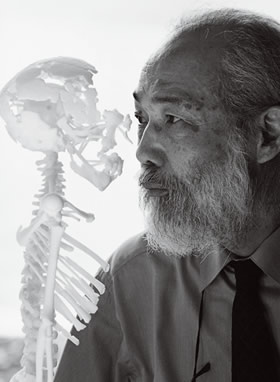 |
| Tennis, Andes, and the bones of a sea bream |
 |
 |
Failing to pass the university entrance exam after graduating from high school, I pretended to attend an exam preparatory school and instead went to tennis practice everyday. The coach, an alumnus of Keio University, complimented my abilities, so I enrolled in Keio’s Faculty of Letters with the intention of joining their tennis team. I was worn down by the preparations for daily practice and ball chasing for the upper classmen, however, and quit after one year. Though I studied Western history, I also visited the Jomon archaeology lab, and was invited to go on an excavation at Kaizuka. That’s when I first realized the attraction of archaeological field work. For the remainder of my college career, every day was spent absorbed in excavations.
At that time, I became interested in the research into ancient civilization in the Andes conducted by the University of Tokyo’s cultural anthropology lab. I began to study the archaeology of the Andes on my own, and became a researcher at the cultural anthropology lab with the intention of going to graduate school.
I happened to become interested in the talks given by Hitoshi Watanabe, an anthropology professor in the School of Sciences, however, and enrolled there. Prof. Watanabe’s specialty was ecological anthropology, and his theory was that the ultimate objective of research into ruins and artifacts was to recreate human behavior.
For my master’s degree, I studied the restoration of the ecology of Jomon-era people. A lot of fish bones were excavated at Kaizuka, and from archaeological purposes, we were able to identify the red sea bream and the perch from the bones. I visited the Tsukiji fish market and determined the relationship between the size of the actual fish and the length of their bones, and estimated the amount of calories obtained by people in the Jomon era from measuring the bones at Kaizuka. From this I learned the importance of changing one’s mindset. |
 |
| Encounter with the Neanderthals |
 |
 |
Just when I was about to resume my research into the people of the Jomon era to obtain a PhD, Professor Hisashi Suzuki, the leader in the field of research into Paleolithic remains, asked me if I would join a trip to Syria and help look for Neanderthal ruins. The area stretching from north of the Red Sea through the Dead Sea, Lebanon, Syria, and Turkey is the oldest corridor through which humankind, born in Africa, passed through on the way to all areas of Eurasia.
We went into the field in the Arab lands in search of unexcavated ruins, and began to look for caves where the Neanderthals lived. I was selected because of my physical strength and archaeological experience, but until then I had no interest in Neanderthals. I studied very hard, got acquainted with the land and people of Arabia, and asked around if there were any caves. This was an enjoyable experience unlike any other in my life because I devoted myself exclusively to my specialty. After that I joined all of Prof. Suzuki’s study groups, and eventually took over leadership of them myself. |
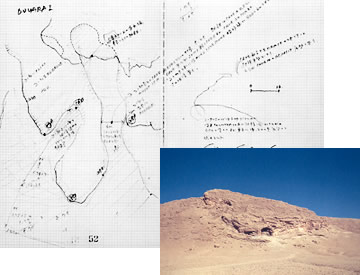 |
| The cave I discovered on my first overseas research trip and the field notes I took |
 |
Empty-handed overseas expeditions and
fruitful domestic research |
 |
 |
Employment was not a problem because I had been hired by the University Storage Center for Research Materials, the University of Tokyo, but I found no Neanderthal fossils. I pursued other research while I was in Japan. One area of research was the pattern of movement of Jomon-era people from east to west in Japan. In eastern Japan, we excavated many tools for hunting and fishing made out of stone and bone, but our analysis of these people in western Japan showed that they primarily gathered and cooked plant resources. It is likely that the smooth transition to rice cultivation in western Japan during the Yayoi era was due to the many agricultural tools that already had been in use since the Jomon era.
Second, there was a history of the Mongoloids crossing the Bering Strait to the north, and the advance to Micronesia and Polynesia in the south. I studied this history by combining the fields of archaeology, anthropology, ecology, and geochemistry. I created the foundation for research into the roots of the Japanese people viewed from a perspective outside Japan. Also, as I saved and studied the materials I had collected in the field, I made a suggestion to covert the University Storage Center for Research Materials into the University Museum. This became the impetus for all universities to create their own museums. |
 |
| Field science in the 21st century |
 |
 |
I unexpectedly dug up the bones of a Neanderthal in a Syrian cave in 1993, a dream I had for 26 years. It was the complete skeleton of a child, and as I looked at it, I thought I would like to see the form of this person who had died at a young age. This was the start of an unprecedented research project for recreating the Neanderthal. Specialists from many fields participated, including mechanical engineers, ergonomists, and information scientists. We used a computer to recreate a child walking and growing.
The next thing I wanted to see was the brain. The brain does not become fossilized. If the skull could be precisely recreated, however, we could determine the size and outward shape of the brain. We could discuss what abilities they had based on the correlation between the shape and function of the brain determined by neuroscience.
The Neanderthals lived in the same time and place as our ancestors, but died out without descendants. One wonders what happened when these two met. Why did they become extinct and our ancestors survive? Using what we learned from those studies as a basis, we would consider our own destiny. I think that will be the field science of the 21st century. |
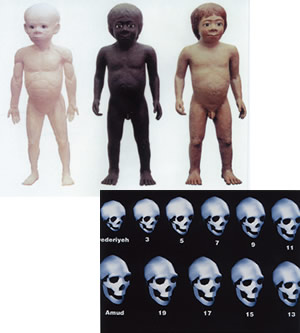 |
The Neanderthal restoration project
(Top)
A detailed replica of the fossil was produced and fleshed out.
(Bottom)
We replicated growth from childhood to adulthood using the skulls of children and adults from the same time period. |
| The remains of the first child excavated were an extremely rare discovery in which most of the body parts were extant from the head to the fingertips. This was an important clue to understanding the Neanderthal skeletal structure. On the right is the world’s first Neanderthal three-dimensional optical model, which was created based on this skeleton. (Created by Incs Inc.) |
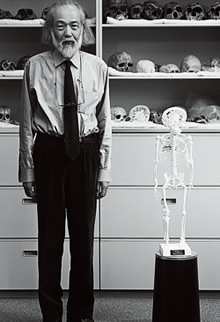 |
|
 |
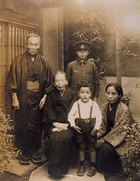 |
 At my childhood home in Osaka. From left: Grandparents, me, (front row), mother (who stressed education) (far right), and my older brother, who was forced to study hard by our mother (Takeshi Akazawa, Professor Emeritus, Nagoya University) At my childhood home in Osaka. From left: Grandparents, me, (front row), mother (who stressed education) (far right), and my older brother, who was forced to study hard by our mother (Takeshi Akazawa, Professor Emeritus, Nagoya University) |
 |
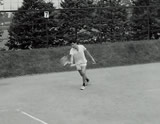 |
 reshman year at university, when I wanted to become a tennis pro reshman year at university, when I wanted to become a tennis pro |
 |
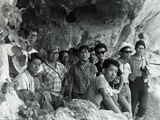 |
 Walking around the excavation site. Going on excavations means three meals, lodging, and passionate involvement in digging. (I am third from right) Walking around the excavation site. Going on excavations means three meals, lodging, and passionate involvement in digging. (I am third from right) |
 |
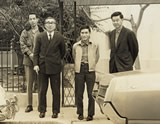 |
 In 1967, my first trip to the Middle East. With Prof. Hisashi Suzuki (second from left) in Beirut. (I am at far left) In 1967, my first trip to the Middle East. With Prof. Hisashi Suzuki (second from left) in Beirut. (I am at far left) |
 |
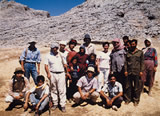 |
 This commemorative photograph was taken with local assistants at an excavation site in Syria. (I am in the center of the back row) This commemorative photograph was taken with local assistants at an excavation site in Syria. (I am in the center of the back row) |
 |
 |
 |
 Family shopping at a Baghdad market Family shopping at a Baghdad market |
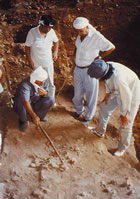 |
 Excavated the fossil of a Neanderthal at last. The man holding the cane is Sultan Muheisen, now a professor at Damascus University. (I am at the far right) Excavated the fossil of a Neanderthal at last. The man holding the cane is Sultan Muheisen, now a professor at Damascus University. (I am at the far right) |
 |
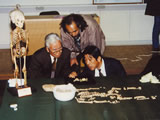 |
 I borrowed the fossil and returned to Japan. It was exhibited at the University of Tokyo. Professor Suzuki also came to see it (far left). At the far right is Yukio Dodo, an expert in archaeological human remains, now a professor at Tohoku University. (I am in the center) I borrowed the fossil and returned to Japan. It was exhibited at the University of Tokyo. Professor Suzuki also came to see it (far left). At the far right is Yukio Dodo, an expert in archaeological human remains, now a professor at Tohoku University. (I am in the center) |
 |
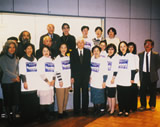 |
 The results of the research and restoration were displayed at the University Storage Center for Research Materials. This became the impetus for establishing the University Museum, the University of Tokyo. Hiroyuki Yoshikawa, then president of the University of Tokyo and a backer of this project, is in the front row center. I am second from the left in the back row. The results of the research and restoration were displayed at the University Storage Center for Research Materials. This became the impetus for establishing the University Museum, the University of Tokyo. Hiroyuki Yoshikawa, then president of the University of Tokyo and a backer of this project, is in the front row center. I am second from the left in the back row. |
 |
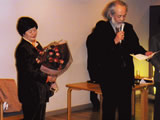 |
 With my wife at the party given when I left my position at the International Research Center for Japanese Studies With my wife at the party given when I left my position at the International Research Center for Japanese Studies |
|
